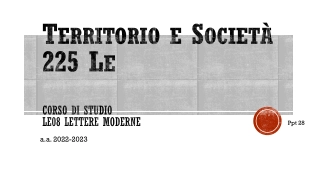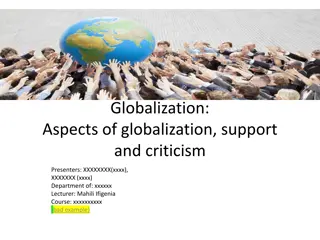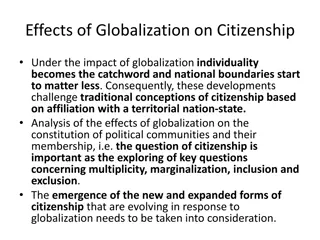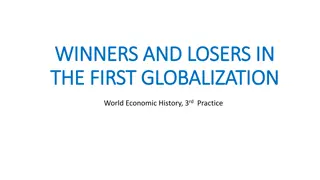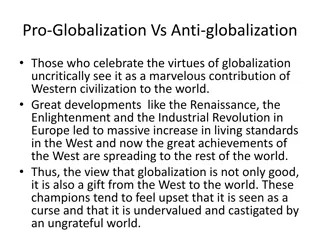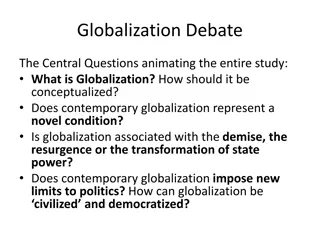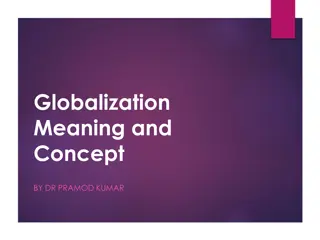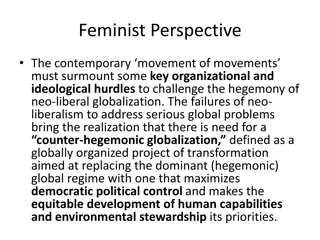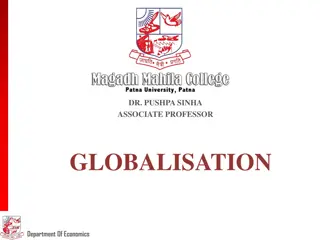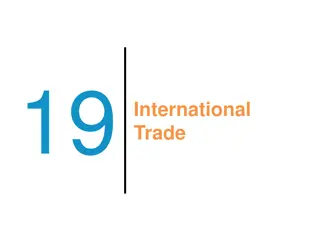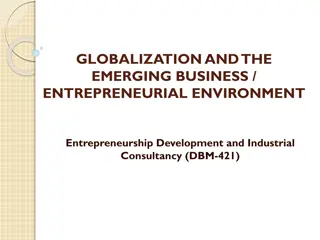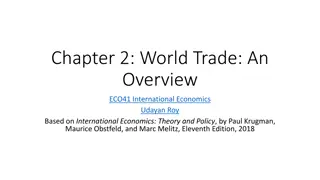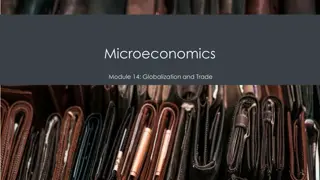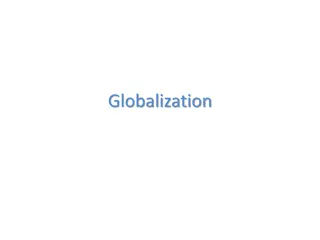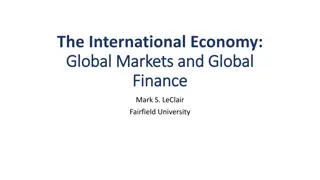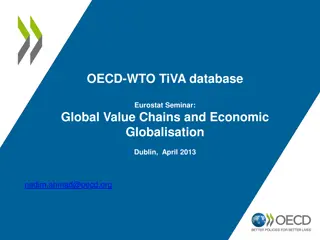Understanding International Trade and Globalization
Explore the concepts of international trade, importing, exporting, visible and invisible trade, and the impacts of globalization on the interconnected world. Learn about the reasons why countries like Ireland engage in trade, as well as the benefits and challenges for businesses. Delve into the balance of trade and payments, and consider the implications of globalized trade.
Download Presentation

Please find below an Image/Link to download the presentation.
The content on the website is provided AS IS for your information and personal use only. It may not be sold, licensed, or shared on other websites without obtaining consent from the author. Download presentation by click this link. If you encounter any issues during the download, it is possible that the publisher has removed the file from their server.
E N D
Presentation Transcript
Chapter 39 Learning intentions In this chapter you will learn to: Explain the term international trade Illustrate the difference between importing and exporting Explain the difference between visible and invisible trade Outline the reasons why Ireland trades with other countries Outline the benefits and challenges for Irish business when it trades with other countries Differentiate between the balance of trade and the balance of payments Explain the term globalisation Debate the implications of the globalisation of trade Appreciate how interconnected the world is and how the actions of some impact on many others. Textbook page reference: 449
Chapter 39 What is international trade? International trade is the buying (importing) and selling (exporting) of goods and services between different countries. Textbook page reference: 450
Chapter 39 What is visible trade? Visible trade involves physical goods that can be seen going out of and coming into Ireland, e.g. food and cars. Textbook page reference: 450
Chapter 39 What is invisible trade? Invisible trade involves services. No physical goods can be seen going out of or coming into Ireland as a result of the sale or purchase of services, e.g. insurance, banking and tourism. Textbook page reference: 450
Chapter 39 What is importing? Importing is buying goods or services from other countries. When this happens, money leaves the country. Textbook page reference: 450
Chapter 39 What is importing? Visible imports are the physical goods that Ireland buys from other countries, for example cars, oil, coal and fruit. Textbook page reference: 450
Chapter 39 What is importing? Invisible imports are services that Ireland buys from other countries, for example Irish people going on holiday abroad. Textbook page reference: 450
Chapter 39 Why does Ireland import goods and services? Climate: Ireland does not have the climate to grow certain products, e.g. bananas, oranges etc. Raw materials: Ireland lacks the essential raw materials or natural resources that would enable us to produce certain goods, e.g. oil. Choice for consumers: Irish consumers want to have a variety of goods and services to choose from, e.g. clothing, choice of holiday destinations etc. Textbook page reference: 451
Chapter 39 Why does Ireland import goods and services? Skills: Certain countries have people with the skills to make certain products, for example Swiss watches, cars etc. Cost: Foreign goods may be cheaper than comparable Irish goods. Small domestic market: The Irish market is small, so certain products cannot be produced economically and must be imported, e.g. cars. Textbook page reference: 451
Chapter 39 What is exporting? Exporting is selling goods or services to other countries. In the case of all exports, money comes into the country. Textbook page reference: 451 452
Chapter 39 What is exporting? Visible exports are the physical products or goods that Ireland sells to other countries, for example meat, dairy products, live animals, ICT equipment, pharmaceuticals. Textbook page reference: 451
Chapter 39 What is exporting? Invisible exports are services that Ireland sells to other countries, for example Spanish students coming to Ireland to learn English or an Irish band performing in another country. Textbook page reference: 451
Chapter 39 Why does Ireland export goods and services? Increased sales/profits: Irish firms can increase their sales and profits by exporting to a larger foreign market. Employment creation: Exporting helps to support jobs in Ireland. The more we sell, the more people we need to make the goods. Demand: There is demand from consumers abroad for Irish products, e.g. beef and butter Earn foreign currencies: The receipt of foreign currencies can boost our country s reserves and provides the finance to help pay for imports. Textbook page reference: 452
Chapter 39 How is international trade measured? The balance of trade is the difference between visible exports and visible imports over a period of time, usually one year. It accounts for trade in goods only. Textbook page reference: 453
Chapter 39 How is international trade measured? The balance of payments is the difference between total exports and total imports over a period of time, usually one year. It accounts for trade in both goods and services. Textbook page reference: 454
Chapter 39 Benefits of international trade for Irish businesses Increased sales: With fewer than 5 million consumers, the Irish market is quite small. By exporting, Irish businesses can increase sales and access much larger markets. Lower costs: Irish businesses have to increase production to satisfy demand from abroad. The more products that are made, the cheaper it becomes to produce each one. This is known as economies of scale. Spreads risk: A business can spread risk by not relying on its local market alone. Raw materials: Irish businesses need to import some raw materials as we do not produce them in Ireland, for example oil. Textbook page reference: 455
Chapter 39 Challenges of international trade for Irish businesses High costs: Ireland is an island, so transportation is more difficult and more expensive for Irish exporters, as goods can only be transported abroad by plane or ship. Languages: Irish exporters may need to make their websites available in many languages for customers in different countries, e.g. Ryanair. Exchange rates: If the euro increases in value, the price of Irish products will become more expensive in countries that do not use the euro . Getting paid: Trying to collect payments from businesses in other countries can be difficult. Competition from low-cost economies: Irish wages are quite high by international standards. This means that it is much cheaper to produce goods in other countries, particularly in Asia and Africa. Textbook page reference: 455
Chapter 39 Free trade Free trade occurs when countries can buy and sell without any trade barriers or restrictions, such as customs duties on goods. Textbook page reference: 456
Chapter 39 Barriers to trade Governments impose trade barriers to limit or restrict international trade. Textbook page reference: 456
Chapter 39 Types of trade barriers Tariff: This is a tax, for example customs duties and import duties, that a country adds to imports to make them more expensive and therefore less attractive for customers to buy. Quota: Countries limit the amount of a good that can be imported into their country. This should increase demand for home-produced goods and services. Embargo: A country can put a complete ban on goods being imported from a certain country. Subsidy: This is a direct payment to a domestic producer. It will reduce the cost of production and makes domestically produced goods relatively cheaper when compared to imports. Textbook page reference: 456
Chapter 39 Why do countries impose barriers to free trade? To protect their domestic industries To protect domestic employment To protect against cheap labour economies National security Textbook page reference: 456 457
Chapter 39 Enterprise Ireland Enterprise Ireland is the state agency that helps Irish businesses that want to sell their products or services to other countries. Textbook page reference: 457
Chapter 39 Globalisation Globalisation is the process by which the world becomes interconnected as a result of increased trade and cultural exchange. In effect, the world becomes one big marketplace. Textbook page reference: 457
Chapter 39 Globalisation A global business sees the world as one market and production location. It provides the same product worldwide. Textbook page reference: 457
Chapter 39 Globalisation A global business uses a global marketing strategy, which involves the same marketing mix of product, price, place and promotion (the 4Ps) throughout the world to build a global brand. Coca-Cola and McDonald s are examples of global businesses. Textbook page reference: 457
Chapter 39 Reasons for the development of global businesses Increased sales: To increase sales and to make higher profits. Mass production: This allows the business to have economies of scale the more they produce, the lower the cost per unit. Reduction in barriers to trade: More economies are open to international trade, while advances in digital technologies and transportation make it quicker and cheaper to operate across the globe. Developments in digital technology: Communication is faster and easier with the use of video conferencing, email, etc. Textbook page reference: 458
Chapter 39 Global product The company will try to use the same brand name and have the same product design all over the world. The product may need to be adjusted to reflect technical, legal and language Textbook page reference: 459 differences.
Chapter 39 Global price Global firms try to charge a similar price in each market, but the price may vary in different countries due to the following factors: A higher standard of living in some countries may lead to the company charging a higher price More expensive transport costs to get the product into a country may lead to a higher price. More competition may lead to lower prices. Exchange rate fluctuations may cause the price to change. Textbook page reference: 459
Chapter 39 Global place This is how the global company gets their product to the market. The company could sell directly to customers or use a distribution agent. Many global businesses rely on local agents and distributors to deliver their products. Textbook page reference: 459
Chapter 39 Global promotion The company will try to use the same advertising all around the world, but this may not always be possible because of differences in language and culture. Textbook page reference: 459
Chapter 39 Implications of globalisation for businesses More competition: Businesses will face greater competition as barriers to international trade are removed. More export opportunities: Bigger markets will lead to more export opportunities. Economies of scale: Mass production is a feature of globalisation. It also reduces unit costs for production, distribution and marketing. Need for quality and innovation: Irish business may need to rely on high quality or innovation as alternative ways of competing in global markets. Takeovers: Successful businesses may be taken over by larger global companies. Textbook page reference: 460
Chapter 39 Implications of globalisation for consumers Lower prices: Consumers may benefit from lower prices as global producers use economies of scale to cut production costs. Increased choice: Consumers benefit from a greater choice of products and brands. Textbook page reference: 460
Chapter 39 Implications of globalisation for the economy and society More trade: Globalisation has led to a huge increase in the volume of international trade. Employment: Globalisation has led to increased levels of employment, but there have been changes in the types of employment. Increased use of resources: The economic growth and production demands caused by globalisation have put a greater strain on scarce resources. Transport and communications: Globalisation has helped to bring about advances in transport and communications networks, but it has also led to concerns about air miles . Textbook page reference: 461
Chapter 39 Implications of globalisation for the economy and society Foreign direct investment (FDI): Globalisation has increased the level of FDI in many regions. Distribution of wealth: While globalisation has increased the income level and wealth of many people worldwide, the wealth is not being shared equally. Cultural issues: Globalisation relies on selling the same products to all consumers, which has led to concerns about cultural uniformity, where everyone wants to be the same or to copy Western or European lifestyles. Textbook page reference: 461
Chapter 39 Recap and review Can you? Explain the term international trade Illustrate the difference between importing and exporting Explain the difference between visible and invisible trade Outline the reasons why Ireland trades with other countries Outline the benefits and challenges for Irish business when it trades with other countries Differentiate between the balance of trade and the balance of payments Explain the term globalisation Debate the implications of the globalisation of trade Appreciate how interconnected the world is and how the actions of some impact on many others.
Chapter 39 Credit slide Shutterstock


